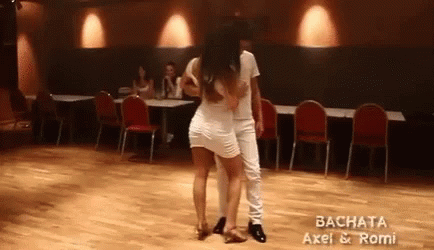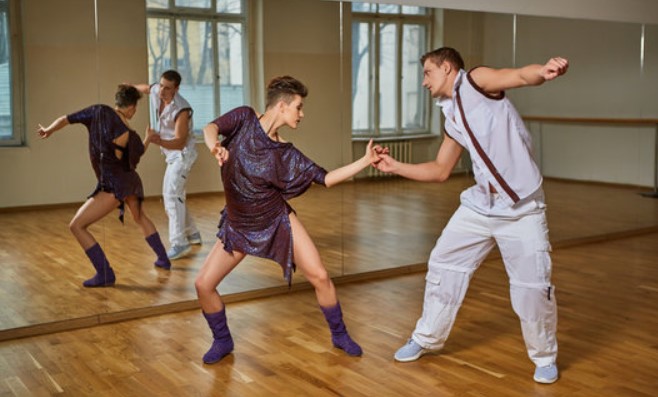From the Dominican Republic, the bachata dance has spread all around the globe as one of the most popular Latin dances out there. It is energetic, sensual, and has an impassioned rhythm that will keep anyone on their toes.
If you’ve ever seen a performance live, then you will have known why this dance has always been a treasured part of the dancing world and hasn’t faded the slightest from popularity since it blew up in the 90s!
In this article, we’ll explore the essence of Bachata and uncover the secrets behind its enduring appeal!
Table of Contents
What Is The Bachata Dance?
Bachata dance is a captivating and sensual partner dance. The key characteristics of the dance are the smooth, intimate movements and passionate sense of connection between partners.
Bachata has no “standard” position like many other ballroom dances. Instead, couples can choose between open, semi-closed, or closed positions – whichever is the most comfortable.
This gives bachata dancers the ability to express themselves more freely.
And unlike other Latin dances, such as salsa, Bachata focuses less on turn patterns.
Bachata can be danced on any beat of the musical phrase while maintaining the basic dance sequence. This allows the dancers to interpret the music depending on its rhythm and mood.
Bachata Dance Origin & History
Bachata dance has a fascinating history that has evolved over the years. The original social dance, often called “authentic/Dominican” bachata, emerged in the Dominican Republic during the 1960s.
In its traditional form, the authentic bachata was typically danced in the closed position with a close embrace and intimate skin-to-skin contact. In this respect, it’s very similar to the bolero.
The bachata dance’s basic steps involved moving within a small square – side, side, forward, and tap with the toes, followed by side, side, back, and another tap.
The form of bachata usually danced today in Western countries, and much of the world appeared in the late 1990s. Dancers in the Western world began creating new dance forms influenced by bachata music.
The most well-known example is the side-to-side step, often accompanied by an exaggerated hip “pop” during the tap.
The most striking difference between this new variation of the bachata and the dance was that dancers typically use open positions and variations instead of dancing in the closed position.
Today, Bachata continues to be danced globally and has undergone further evolution.
It is now often danced to faster music, incorporating additional footwork, simple turns, and rhythmic freestyling. Dancers can freely alternate between close (romantic) and open positions.
We also see the use of hip movements combined with the signature tap or syncopation. Many dancers have also incorporated a subtle bouncing motion or a slight spring to their legs to create a more dynamic and creative performance.
Check more: Most Famous Bachata Dancers in the World
Bachata Dance Basic Steps
If you want to start dancing the bachata, you must first master the basic bachata dance steps. Once you’ve got it down, you can move to more advanced techniques and eventually onto freestyling.
The basic sequence follows a complete 8-count, moving within a square pattern.
Side Step
Begin by stepping to the side with your left foot (or right foot, depending on the starting position). Shift your weight onto your left foot as you do.
Together Step
Bring your right foot next to your left foot and close their distance. Return your weight to your right foot.
Forward Step
Take a forward step with your left foot, moving slightly diagonally forward. Transfer your weight onto the left foot.
Tap or Syncopation
Finally, tap your right foot next to your left foot or add syncopations (steps in between the beats).
As mentioned earlier, Bachata allows dancers to adapt their movements to any beat within the musical phrase as long as the basic dance sequence of three steps and a tap or syncopation is maintained.
For instance, you can start the sequence on the 1st beat of the musical phrase, with the tap landing on the 4th beat. This flexibility allows for creative expression and synchronization with the music’s rhythm.
Buy 3 DVD series – Bachata Dance for Beginners Here!
Bachata Dance Styles
The bachata dance has continually evolved over time, and here’s the evidence.
There are many variations of the bachata around the world, each with its own qualities and rules.
Western “Traditional” Style
The Western “traditional” style emerged in the late 1990s in the Western world. This was the dance that most bachata clubs and dancers today are modeled after.
It replaced the box-step pattern in the original bachata with a side-to-side movement, changing direction after every tap.
Other deviations from the original style include the close proximity between partners (locked in the closed, romantic position), soft hip movements, and a small “pop” of the hip on the fourth step.
You can differentiate it from other bachata variations by its relative simplicity in terms of choreography and limited turns. And, it often has many stylings and moves from ballroom dance, like dips and other show moves.
Bachatango
Bachatango is a fusion style originating from Turin, Italy. It blends elements of Bachata and Tango.
This unique style combines the sensuality and passion of both dances, incorporating the “pop” count in bachata and the characteristic kicks of the tango.
The Bachatango is almost unheard of in the Dominican Republic. However, it was once very popular in foreign ballrooms outside of the Caribbean.
Its popularity has waned somewhat, and it’s rarely seen in the social dance scene anymore.
Bachata Fusion
The Tango wasn’t the only dance that’s been merged with the bachata over the years.
Many have also experimented with fusing bachata with salsa, hip-hop, and other contemporary dance. We refer to all these combined dances as simply “Bachata Fusion”.
This style encourages creativity and experimentation, allowing dancers to incorporate different techniques, movements, and styles from diverse dance genres into their Bachata routines.
Sensual Bachata
As its name suggests, the Sensual Bachata is characterized by its highlight of sensual movements from the dancers.
Sensual Bachata strongly emphasizes connection, musical interpretation, and creating an intimate atmosphere between partners.
Ballroom Style
The Ballroom style of Bachata draws inspiration from traditional ballroom dance techniques. It combines a ballroom’s elegance and precision with Bachata’s energetic and sensual rhythm.
However, unlike the Sensual Bachata, the ballroom-style bachata focuses more on control and posture. In other words, it’s a more “formal” dance.
You’ll find a lot of graceful spins, intricate footwork, and polished partnering techniques when you watch a performance of this variation.
Bachata Dance Music
Many times in this article, we have mentioned “bachata music”.
So, what is it, exactly?
Bachata dance music is a whole genre, not unlike salsa or waltz music. A song is typically counted in a 4/4 time signature, similar to Salsa. A full musical phrase is counted up to 8 beats.
Traditional Dominican Bachata, known as “La Musica del Amargue”, is characterized by its fast tempo, African rhythms, and lyrics that often express lost love and suffering.
Over the years, and as bachata’s popularity surged worldwide, the music has become influenced by other genres and styles.
In a well-organized bachata dance event, you will find a live bachata dance giving the dancers the tune to dance on.
A typical Bachata band consists of lead and rhythmic guitars (including the requinto), bass guitar, bongos, the guira, and vocalists.
Some traditional-sounding Bachata bands include Aventura and Grupo Extra (we highly recommend checking out some of their classic hit recordings).
In the 2000s, artists like Romeo Santos and Toby Love incorporated electronic synths and followed a standard pop music structure. These are the new waves of bachata hits that are still enjoyed today.
The demand for new music has also led to the emergence of DJs such as DJ Tronky, who produce Bachata covers of popular songs, like this bachata cover of Glimpse of Us by Joji.
Bachata Dance Attire
Generally speaking, there’s no costume in an informal bachata dance event. You only have to come wearing attires that are most comfortable and dance-fit.
For men, pants that are a regular fit and allow for better lower body movement are recommended. Sometimes, even shorts are acceptable if the weather’s warm.
If you’re afraid of sweat stains, wear an undershirt, preferably made of moisture-wicking material.
Dance shoes are the preferred option for the feet, but sneakers can also be used if they don’t have a rubber sole.
For women, flowy skirts or dresses with spandex shorts underneath are often preferred. Leggings and shorts are also suitable options, as long as they are not too short.
If you choose to wear bottoms, you can pair them with regular blouses, tank tops, or even crop tops.
Women’s footwear for Bachata is ideally dance shoes, but short heels with at least one strap can also be worn. Flats or sneakers without a rubber sole can also work at certain joints and events.
Final Words
And that’s all that you need to know about the bachata dance!
This enduringly popular dance has been a highlight at many Latin dance competitions ever since it rose in prominence in the 90s. And from what we’ve seen, its popularity isn’t going to wane any time soon.
What part of the bachata dance do you enjoy the most? Do you plan on taking classes or joining a bachata club? We’d love to hear what you think in the comments!



